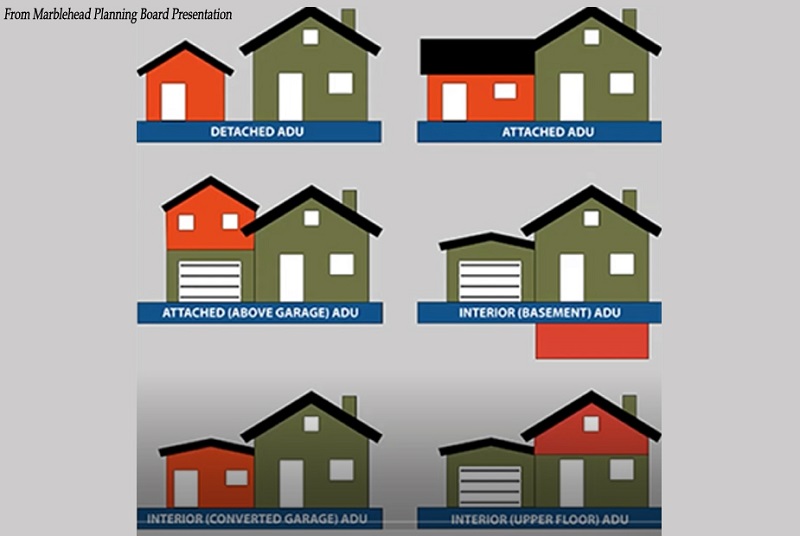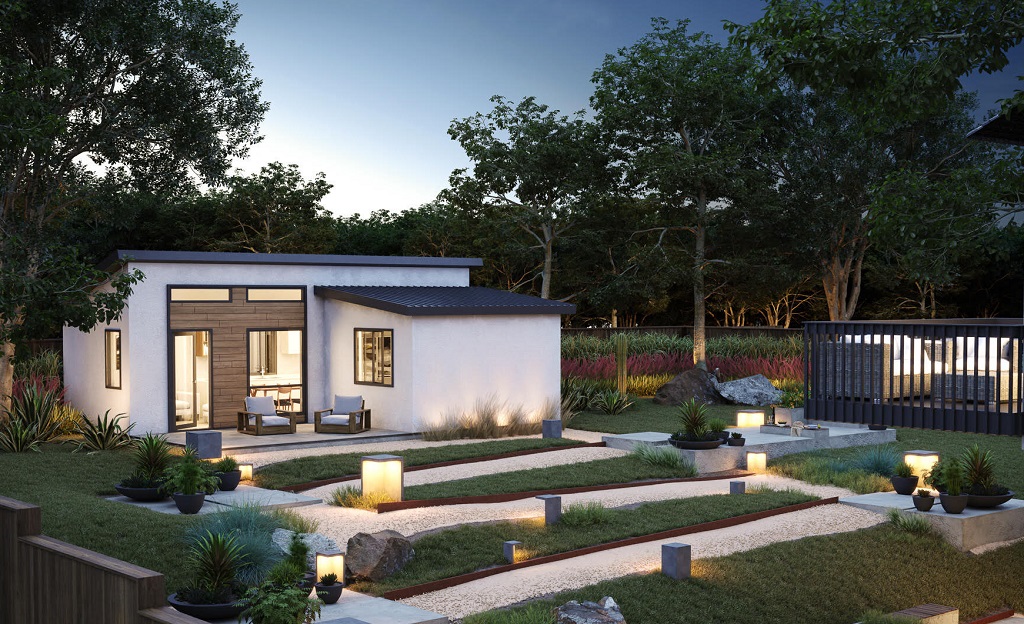Updated: December 26, 2022
The main image is courtesy of Modern Empathy and is their Nano L ADU model, rendered by 3DUS.
A groundswell of anxiety has hit neighborhood communities as local, county and state jurisdictions have continued to relax rules on constructing ADUs (Accessory Dwelling Units) in residential zones.
These smaller living structures, located on the same parcel of land as an adjacent owner-occupied, main single family home, continue to generate a lot of interest from both homeowners wishing to build ADUs, as well as renters looking to find affordable living arrangements in desirable neighborhoods.
To get a better understanding of what has been fueling homeowners’ interest in ADUs, be sure to read our overview of the many benefits of Prefab ADUs, as well.
Table of Contents
- Massive Growth in ADU Permits
- The Great ADU Debate
- Community Issues Pertaining to ADUs
- Negative Perceptions of ADUs on Single Family Residential Neighborhoods
- The Bottom Line on the Impact of ADUs
- ADU Regulation Resources
Also see:
Massive Growth in ADU Permits
In our prefab ADU article, we stated that anyone interested in monitoring the latest trends in ADUs should watch California closely. California’s legislative changes have caused a massive increase in ADU permits between 2016 and 2019 with a 1,059% uptick of permits issued: from 1,269 permits in 2016 to 14,702 in 2019! Los Angeles leads the trend with almost 7,000 permits issued in 2019, an enormous surge from the paltry 15 permits issued in 2013.
We also recommend tracking Seattle, Portland, Denver and Montgomery County, Maryland to stay abreast of recent changes to ADU rules and policies.
The Great ADU Debate
Since regulations in California were changed, as early as 2017, which opened up the construction of ADUs and conversion of garages to ADUs, the pros and cons of ADUs have been debated at City Council meetings, in online neighborhood social media groups, and in-person, neighbor to neighbor.
To spur construction, local and state governments have developed plans to expedite the permitting and building process. Many are offering ADU financial incentives in connection with expenses for the planning, construction and operations of an ADU, with the goal of increasing affordable rental inventory for low to moderate income individuals.
Community Issues Pertaining to ADUs
There have been a number of issues brought forth in various forums discussing the impact of ADUs on local communities. Our goal in this article is to help homeowners realistically understand the larger, community issues pertaining to ADUs, while encouraging them to participate in the planning of their local communities and neighborhoods.
Though we strongly believe that the aggregate benefits of ADUs significantly outweigh potential drawbacks, especially for homeowners, we recognize that this is only possible with effective planning and management.
It is equally important for homeowners to understand their personal rights and options for building and owning an ADU, as well as to understand how to best manage their communities that will encounter a growing number of these units over coming years.

Image courtesy of the Marblehead Massachusetts Planning Board.
Negative Perceptions of ADUs on Single Family Residential Neighborhoods
The most commonly expressed concerns by homeowners, pertaining to the proliferation of ADUs in residential communities, can be grouped into these categories:
- Increased Density
- Increased Traffic & Reduced Parking
- Higher Percentage of Renters
- Declining Home Values
Increased Density
“ADUs will alter the fabric of our quiet single family residential neighborhood. The area will attract more transients and become overpopulated”
The belief that ADUs can transform an otherwise quiet neighborhood into a “transient renter’s paradise” or an unregulated tourist attraction for disruptive partiers is a far stretch.
First, many homeowners do not build ADUs primarily for rental income, but rather for the extra space and functionality that it affords an existing family. According to a Maxable study, the primary reason that homeowners build an ADU is for aging family members.
Second, since most people are spending more time at home, the need to have a sanctuary for work, private time, children’s study rooms, and more is real. Chances are, your neighborhood population will remain relatively flat, as the extra living space serves as an extension for existing residents.
In the event that your neighbor does decide to rent an ADU, local laws may only allow up to two people for the maximized square footage. Many states have limits on the size and occupancy of an ADU, so there is no need to worry about a family of four moving into your neighbor’s backyard.
Since ADUs are built on a controlled unit-by-unit basis, the neighborhood’s character is likely to remain intact from a density perspective.
As far as noisy, hyperactive ADU tenants, the rules of your jurisdictions will still apply. Quiet hours will still be enforced regardless of the density of a parcel of land. Concerns about “transients” inhabiting the quiet, residential neighborhood, are far from realistic, as anyone looking to lease out an ADU is looking to reap a fair return-on-investment and would probably charge a reasonable, market rate to attract desirable and responsible tenants.
“Rental units, with more people than bedrooms, will be a drain on existing neighborhood services: sewer systems, water usage, trash collection and other resources”
Limits on ADU size and restrictions on habitability are key to insuring that ADUs do not degrade existing services such as sewage, water, electricity and other resources.
Existing R-1 zoning codes must be enforced, specifically rules pertaining to “Use” (how a structure is used) and “Density” (how many structures and residents per parcel).
Increased Traffic & Reduced Parking
“Traffic and parking will become a problem as more cars are parked on residential streets, if garages are being converted to ADUs”
Requirements to provide off-street parking should be considered for all ADU-zoned areas. These off-street parking mandates are gaining favor with both proponents and opponents of ADUs, as both sides recognize the need to enforce a healthy percentage utilization of on-street parking, on average around 60%.
Interestingly, studies conducted in both Portland, Oregon and the San Francisco Bay Area found that ADU households own an average of just 0.9 cars each. Thus, the conclusion that ADU households own fewer cars than their traditional “main home” counterparts (currently 1.8 vehicles for the national average) would suggest that the parking issue is overblown.
Seattle, Portland, Denver and Santa Barbara County are the exceptions to this approach, having recently removed requirements for a dedicated parking space per ADU.
Higher Percentage of Renters
“Our neighborhood will become overrun with renters, which will lead to blight since they have no pride of ownership of the property”
The Owner-Occupancy Provision
In almost all of the ADU laws we reviewed, a provision exists that protects against excessive rentals. With the exception of Seattle and Portland, if a homeowner builds an ADU, he cannot rent out both the ADU and his main property at the same time. This is known as the “owner-occupancy provision” which helps maintain the R-1 zone (zones designated for single-family residences) and prevents them from becoming denser R-2 zones.
Since many regulations require that homeowners reside on the premises, either in the main home or in the ADU, the vacant-owner concern is a non-issue. Furthermore, there are limits on the size and number of ADUs on a given parcel of land, which will directly limit the number of renters permitted to occupy the space. Many cities have occupancy codes that prevent overcrowding based on health and safety factors.
Also keep in mind that a homeowner may build an ADU for reasons other than rental income, such as housing elderly parents, adult children, or full-time caregivers. These are all situations that do not, in any way, lead to degradation of a property due to having excessive renters.
Declining Home Values
ADUs provide such a wide range of flexible usage over long periods of time for which homebuyers are demonstrating a willingness to pay a premium. An important caveat, of course, is that any newly built ADU should be professionally built, meet local building standards, and mesh well with the design of the main house, and fit in with the overall neighborhood aesthetic.
Recent trends from Forbes confirm that properties with ADUs are selling faster and increasing in value, compared to properties without ADUs.
The biggest threat to declining home values due to ADUs would be the unrealistic scenario of a proliferation of low-quality, unattractive structures, unabated by local design approval boards and building codes.
The reality is, the building and design quality of ADUs are continuing to improve, with the finished product often being at a higher standard than that of the corresponding main home. The growing awareness of the many benefits of ADUs are fueling the demand for properties with ADUs. In particular, ADU rental income is expanding the buying power of prospective homebuyers.
The biggest risk pertaining to valuations and ADUs involves the timing of a sale soon after the construction of a high-end ADU. The demand for quality ADUs will continue to grow for many years to come, which will push home values further upward. However, in the short-term, a positive return on an ADU investment cannot be guaranteed.
The Bottom Line
ADUs have always been part of the housing stock, they just fell out of favor when zoning codes discouraged their construction
In July 2020, Freddie Mac published a research report that estimated the number of US residential properties with ADUs at 1.4M. Their research found that for-sale listings in the MLS of ADUs had grown from less than 2,000 per month in 1997 to more than 12,000 in 2018. Between 2009 and 2019, the number of first-time ADU listings averaged 8.6% year-over-year growth.
Approximately 70,000 properties with ADUs were sold in 2019, which represented 4.2% of total homes sold on MLS. By comparison, in 2000, only 8,000 properties (1.1% of total sales) with ADUs were sold.
As a percentage, ADUs still remain a very small portion of the overall housing stock. In 2019, for example, the share of active for-sale listings with ADUs reached just 6.8%.
When thinking of the future of single family neighborhoods, we are encouraged when thinking of the confluence of these growing trends:
- Aging in Place
- Multigenerational Households
- Supplemental Rental Income
- Remote Offices & Home Businesses
ADUs are proven invaluable assets and safety nets that are helping homeowners and their families weather unpredictable futures.
ADU Regulation Resources
- The Evolving World of ADU Regulation by Donald Elliott, FAICP, of Clarion Associates (Video)
- The Evolving World of ADU Regulation (Slides)
- ADU Regulations in California – by City
- ADU Licensing Requirements – Montgomery County, MD
- California Department of Housing & Community Development – ADU Handbook
- Oregon – Guidance on Implementing the ADU Requirement
- Seattle, WA Department of Construction – ADU Guidance
- Austin, TX – ADU
- Florida Housing Coalition – ADU Guidebook
- New York Senate Bill S4547 – Regulation of ADUs
- City of Beverly (Boston Metro) Accessory Dwelling Unit Zoning Forum
More ADU Articles from Purgula
- Does an ADU Add Value to Your Home? Surprising Trends from HomeLight
- 5 Inspired ADU Designs for Today’s Market
- Top PreFab ADU Vendors
- These Features Will Make Your ADU More Desirable & Valuable
- Want a Nontraditional House? Here’s How to Finance It!
- Why Homeowners Should Invest in a Prefab ADU
- Choosing Between a Prefab ADU & a Traditional Stick-Built ADU
- 10 Ways to Monetize Your Home
- Best Online Legal Services for Homeowners & Property Owners
- What Homeowners Should Know About Proptech: Monetization
- How Landlords Can Find The Perfect Tenant
| Purgula is reader-supported. When you click on links to other sites from our website, we may earn affiliate commissions, at no cost to you. If you find our content to be helpful, this is an easy way for you to support our mission. Thanks! Learn more. |








There is little compromise with California’s pathetic Gavin Newson and his sidekick Senator Scott Weiner playing king-god and dictating for every town and city. No voter rights here. Most of these ADU’s are not “affordable” housing and impinge on the rights of those neighborhood communities that have put skin in the game and built the communities they want to tear down (although you won’t find any near his house). They will go beyond and even allow 2 story ADU’s and even ADU’s in front yards – anything to get their developer kickbacks. Control the foreign investors (either ban or have quotas) buying affordable starter homes in droves and stop illegal immigration and sanctuary cities and we will instantly have more affordable home inventory.